
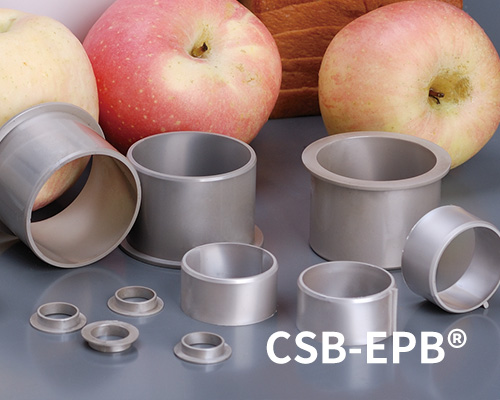
● Continuous working temperature: -100℃/+250℃
● Suitable for high load and lovo speed operation
● High load capacity at higher temperature
● Good chemical resistance
● FDA grade
Material properties | Standard | Unit | CSB-EPB5A |
General properties | |||
Color | - | - | Beige |
Density | ISO1183 | g/cm3 | 1.28 |
Max. moisture absorption, 50%RH | ISO62 | % | 0.3 |
Max. water absorption | ISO62 | % | 0.5 |
Coefficient of sliding friction(steel) | ITS025 | µ | 0.25-0.40 |
Max. PV value | ITS026 | N/mm2×m/s | 0.25 |
Mechanical properties | |||
Flexural modulus | ISO178 | MPa | 3600 |
Flexural strength | ISO178 | MPa | 140 |
Max. static load | ITS027 | MPa | 90 |
Max. dynamic load | ITS028 | MPa | 46 |
Shore hardness | ISO868 | D | 80 |
Physical and thermal properties | |||
Long-term application temperature | ITS029 | ℃ | +250 |
Short-term application temperature | ITS029 | ℃ | +300 |
Lowest application temperature | ITS029 | ℃ | -100 |
Thermal conductivity | ISO22007 | W/m/K | 0.24 |
Coefficient of thermal expansion | ISO11359 | K-1×10-5 | 9 |
Flammability | UL94 | Class | V0 |
Electrical properties | |||
Volume resistance | IEC60093 | Ω·cm | >1014 |
Surface resistance | IEC60093 | Ω | >1013 |
*ITS: CSB company's internal test standards. **Test temperatures are 23℃ unless otherwise stated.


The max PV value of the CSB-EPB5A plastic bearings is 0.25N/mm2×m/s which determines the load capacity of bearing is inversely proportional to the speed. Please refer to the chart for more detailed information (Graph EPB5A-1).

CSB-EPB5A allows the Max static load of 90Mpa, The max compressive deformation rate under the max load is listed in Graph EPB5A-2, The actual load capacity of bearing is slightly less than 90Mpa, The bearing load is variable against the speed and temperature, Fast speed (Vmax: 0.6m/s) results into higher temperature (Tmax: 250℃) which decreases the load capacity of the bearing. Please refer to the Graph EPB5A-3 for such variation.
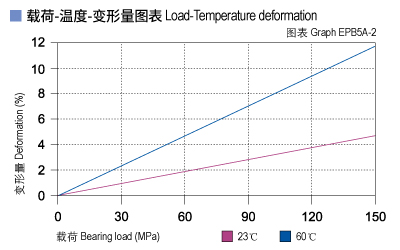
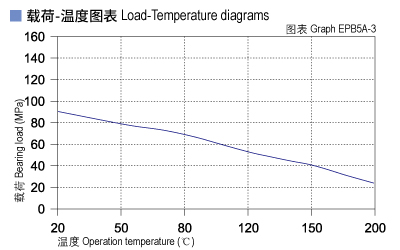
CSB-EPB5A Bearing Friction factor is increased along with the increasing of the operation speed under certain loading (See Graph EPB5A-4). The friction factor of CSB-EP5A is decreased along with the loading increasing not over 20Mpa (see Graph EPB5A-5). The friction factor will not change much along with the speed when the loading is over 20Mpa. The Graph EPB5A-6 shows that the bearing could achieve its best performance when the counter shaft surface roughness is around Ra0.4 to Ra0.9.
| CSB-EPB5A | Dry | Grease | Oil | Water |
| Friction coef. μ | 0.25~0.40 | 0.09 | 0.04 | 0.04 |
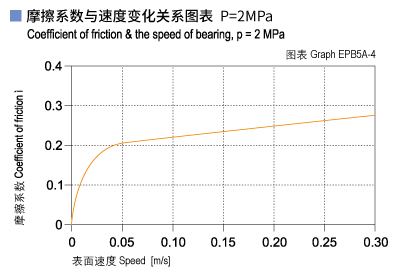

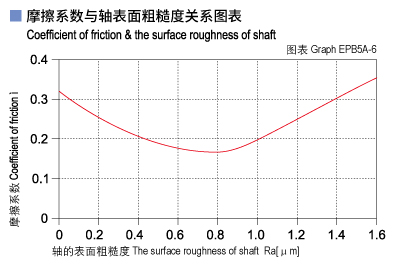
Graph EPB5A-7 and Graph EPB5A-8 show the test results of the material CSB-EPB5A running against different shaft materials. It is suitable for hard Aluminum and hard chrome steel shaft. The hard chrome steel shaft will be better when the loading is getting heavier. Graph EPB5A-7 shows CSB-EPB5A is good for oscillation operation.
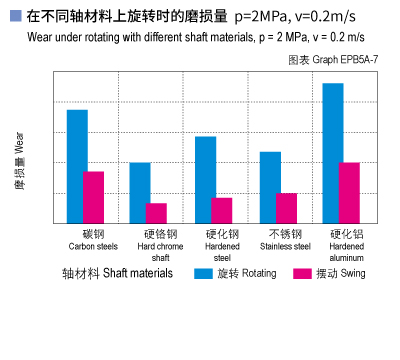
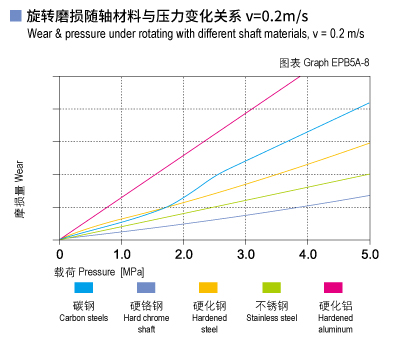
Chemical Resistance of CSB-EPB5A is very good. It can work well in the heavy acid of 65%.
The moisture absorption of CSB-EPB5A plastic plain bearings is 0.3% in standard atmosphere. The max. water absorption is 0.5% in water . These values are very low, CSB-EPB5A plastic palin bearings is very well suited for used in wet applications.

CSB-EPB5A can maintain its performance to be stable even exposed in the UV ray for long period.
CSB-EPB5A Tolerances after pressfit
Diameter [mm] | CSB-EPB5A F10 [mm] | Housing H7 [mm] | Shaft h9 [mm] |
>0~3 | +0.006~+0.046 | 0~+0.010 | 0~-0.025 |
>3~6 | +0.010~+0.058 | 0~+0.012 | 0~-0.030 |
>6~10 | +0.013~+0.071 | 0~+0.015 | 0~-0.036 |
>10~18 | +0.016~+0.086 | 0~+0.018 | 0~-0.043 |
>18~30 | +0.020~+0.104 | 0~+0.021 | 0~-0.052 |
>30~50 | +0.025~+0.125 | 0~+0.025 | 0~-0.062 |
>50~80 | +0.030~+0.150 | 0~+0.030 | 0~-0.074 |
>80~120 | +0.036~+0.176 | 0~+0.035 | 0~-0.087 |
>120~180 | +0.043~+0.203 | 0~+0.040 | 0~-0.100 |
▊CSB-EPB® Plastic Bearings Finder[V2.1] is based on the analysis and calculation of a large number of test data in CSB® laboratory. You can calculations material data by entering parameters such as bearing load, speed, and temperature, and finally output material adaptation data.
▊Because the system calculate and analyze based on lab data, it can't exactly meet the ractual use requirements absolutly. The system data verification has certain limitations; CSB® recommends that the bearing must be tested again to verify whether it meets the actual use requirements.
▊CSB-EPB® Plastic Bearings Finder output data information is only for design reference, and can not be used as the final standard for determining the bearing material conformity, If you have any questions, please contact CSB® sales engineers.
▊DURAPLAS® Semi-finished Products Finder[V2.0] is based on the analysis and calculation of a large number of test data in CSB® laboratory. You can calculations material data by entering parameters such as bearing load, speed, and temperature, and finally output material adaptation data.
▊Because the system calculate and analyze based on lab data, it can't exactly meet the ractual use requirements absolutly. The system data verification has certain limitations; CSB® recommends that the products must be tested again to verify whether it meets the actual use requirements.
▊DURAPLAS® Semi-finished Products Finder output data information is only for design reference, and can not be used as the final standard for determining the bearing material conformity, If you have any questions, please contact CSB® sales engineers.
| Medium | EPB5A bearings resistance |
| Alcohol | Resistant |
| Hydrocarbons | Resistant |
| Greases. oils | Resistant |
| Fuels | Resistant |
| Diluted acids | Resistant |
| Strong acids | Conditionally resistant |
| Diluted alkalis | Resistant |
| Strong alkalis | Resistant |
Please select bearing material and medium...
▊CSB® bearing material chemical resistance data is a comparison test result of the CSB chemistry laboratory using laboratory specimens or similar chemicals at room temperature 23 ℃, without considering the impact of other temperatures and chemical medium mixtures on the chemical resistance of CSB® bearing materials ; Therefore, this data can only act as a reference. CSB® recommends that the chemical resistance of actual parts should be tested under application conditions and verify the suitability of the bearings.
Wear resistance material with low friction factor without PTFE and Silicon. It comforms to the FDA standard and could be contacted with food directly. It is suitable for the applications in water or with the temperature...
moreHigh temperature and wear resistance material comforms to FDA regulation. It is suitable for the food machinery where the food is directly contacted with the material under the high temperature of 180℃.
moreIt is a PTFE and Silicon free material widely used in the food and packing machineries. Continuous working temperature: -40℃/+80℃. No special requirement on the surface roughness. Low friction coefficient. Applicable...
moreIt is a wear resistance material for working temperature lower than 80℃. The application is for the condition where the shaft hardness is not critical. The white color of the material is also commonly used...
more